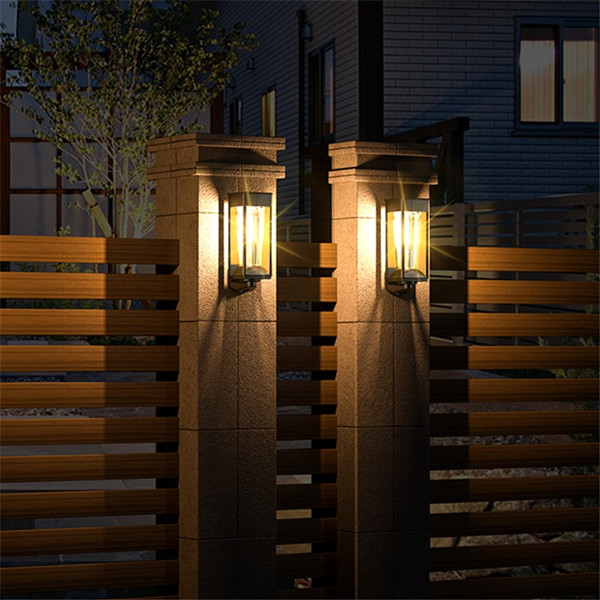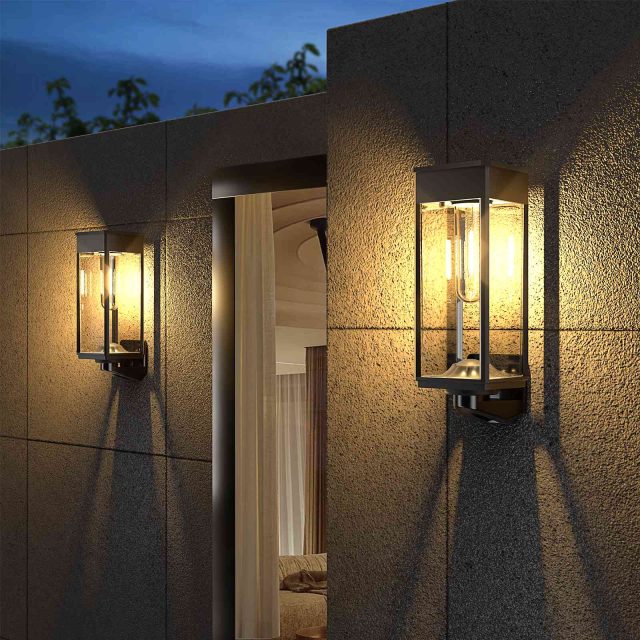Solar wall lights are a versatile, eco-friendly solution for illuminating and enhancing your home’s exterior. Combining aesthetic appeal with sustainable energy, these lights transform walls into functional and decorative features without the hassle of wiring or high electricity costs. This comprehensive guide covers design options for solar powered wall lights, detailed installation steps, systematic maintenance routines, troubleshooting tips, and creative DIY ideas to elevate your outdoor wall lighting.
Diverse Design Options for Solar Wall Lights
Choosing the right solar wall light involves aligning the fixture with your wall type and preferred aesthetic. The design diversity ensures a perfect match for any home exterior.

1. Wall Type Compatibility
- Brick or Concrete Walls: These sturdy surfaces support heavier solar outdoor lights, such as stainless steel or cast aluminum models. Use masonry screws and a 6mm drill bit for secure mounting. For example, a robust lantern-style light complements a brick facade.
- Wood or Siding Walls: Lightweight solar wall lights made of plastic or thin metal are ideal to avoid structural strain. Adhesive mounts or smaller screws (4mm) work well for temporary or rental setups, ensuring minimal damage.
2. Decorative Styles
- Mediterranean Style: Inspired by coastal villas, these solar powered wall lights feature blue or terracotta shades, curved frames, and frosted glass for a warm, diffused glow. They pair beautifully with stucco walls, evoking a seaside charm.
- Nordic Minimalism: Clean, white, or matte black solar wall sconces with simple geometric shapes suit Scandinavian-inspired homes. Their understated elegance enhances light-colored wood or plaster walls.
- Traditional Elegance: Lantern-shaped lights with bronze finishes or intricate filigree designs add timeless sophistication, ideal for colonial or Victorian homes. These work well on brick or stone surfaces.
By matching the light’s material and style to your wall and home aesthetic, you create a cohesive, visually appealing outdoor lighting setup.
Step-by-Step Installation Guide for Solar Wall Lights
Proper installation ensures your solar wall lights perform optimally and look stunning. Follow these detailed steps:
1. Measuring and Marking
- Use a tape measure and chalk or pencil to mark the installation point at 1.5-2 meters (5-6.5 feet) high for optimal illumination. Space lights 3-4 meters apart to avoid overlapping light pools.
- Employ a level to ensure the mark is straight, preventing a tilted appearance. For multiple lights, measure equal distances to maintain symmetry across the wall.
2. Drilling and Fixing
- Select a drill bit size based on your wall type: 6mm for masonry, 4mm for wood or siding. Drill pilot holes at marked points, ensuring depth matches screw length (typically 30-40mm).
- Insert wall plugs for brick or concrete, then secure the light’s mounting bracket with screws. For wood, screw directly into the wall, avoiding knots or weak spots. Use a stud finder to steer clear of hidden electrical wiring.
3. Connecting the Battery
- Open the light’s battery compartment and insert the provided lithium-ion or NiMH battery, ensuring correct polarity (+/-). Secure the cover to prevent water ingress, as most solar wall lights have an IP65 rating or higher.
- Test the light by covering the solar panel to simulate darkness; the light should activate if a motion sensor is included. If not, charge the battery in sunlight for 6-8 hours before first use.
Position the solar panel to face south (in the Northern Hemisphere) for maximum sunlight exposure, avoiding shade from trees or eaves.

Systematic Care for Solar Powered Wall Lights
Regular maintenance keeps your solar wall lights shining brightly and extends their lifespan. Follow this structured care routine:
1. Cleaning the Fixture
- Weekly: Wipe the light’s surface with a soft cloth and mild, non-abrasive cleaner (e.g., diluted dish soap) to remove dust or pollen. Avoid harsh chemicals that could corrode metal or plastic finishes.
- Monthly: Clean the lamp shade or diffuser to maintain light output. For glass shades, use a glass cleaner for a streak-free finish.
2. Protecting the Solar Panel
- Weekly: Check the solar panel for debris like leaves or bird droppings. Wipe with a damp cloth to ensure efficient charging.
- Seasonally: Consider installing a fine mesh or anti-bird netting around the panel to prevent fouling, especially in areas with heavy bird activity. Ensure the mesh doesn’t block sunlight.
3. Checking the Circuit
- Annually: Use a multimeter to test the battery voltage. A lithium-ion battery should read around 3.7V when fully charged; replace if below 3.2V. Inspect wiring for corrosion or loose connections, particularly in coastal areas where salt air accelerates wear.
- Tighten screws or replace weatherproof seals to maintain the IP65 rating, ensuring protection against rain and dust.
Solutions for Common Solar Wall Light Issues
Even high-quality solar outdoor lights may encounter problems. Here’s how to address common issues:
- Loose Fixture: If the light wobbles, add rubber or metal washers between the bracket and wall for stability. Replace stripped screws with slightly larger ones (e.g., 8mm for masonry).
- Dim or No Light: Verify the solar panel receives 6-8 hours of direct sunlight. Adjust its angle or relocate the light if shaded by new growth or structures. Clean the panel to remove dirt buildup. If the issue persists, test the battery and replace if degraded.
- Motion Sensor Failure: For solar motion wall lights, clean the sensor lens to remove dust or cobwebs. Adjust sensitivity settings to avoid false triggers from wind or small animals. Ensure the sensor faces the intended detection zone (e.g., 120° angle, 5-10 meters range).
DIY Creative Ideas for Solar Wall Lights
Elevate your solar wall lights with these creative touches to enhance aesthetics and functionality:
- Plant Integration: Plant climbing vines like ivy or jasmine near the light to frame it with natural greenery. Ensure vines don’t cover the solar panel or sensor. This creates a lush, organic look for garden or patio walls.
- Festive Ambiance: Use solar wall lights with adjustable color or brightness settings to create holiday themes. For Christmas, set lights to red or green hues; for Halloween, use amber tones. Bitpott’s smart solar outdoor lights allow app-controlled color changes for such occasions.
- Shadow Patterns: Choose lights with perforated or lattice shades to cast decorative shadow patterns on walls. This adds an artistic flair, especially for art deco or Mediterranean-style homes.
- Grouped Installations: Arrange multiple solar wall sconces in a staggered or linear pattern to create a dramatic effect on long walls, such as along a driveway or fence line.
Environmental and Practical Benefits of Solar Wall Lights
Solar powered wall lights are a sustainable choice, reducing reliance on grid power and lowering your carbon footprint. A single light can save 5-8 kg of CO2 annually compared to a 40W traditional fixture, equivalent to driving 20 fewer miles per year. Over a 5-year lifespan, this translates to significant environmental impact, especially when multiple lights are used. Additionally, solar wall lights eliminate electricity costs, saving $10-$20 per light annually, depending on local rates.
Their versatility makes them ideal for various settings, from urban apartments to rural cabins. With no wiring required, solar outdoor lighting suits renters or homeowners seeking quick, non-invasive upgrades. The IP65 rating ensures durability in rain, snow, or heat, while modern designs enhance curb appeal.
User Insights for Solar Wall Lights
To illustrate their impact, consider these user experiences:
- A homeowner in Arizona used modern solar wall lights on their stucco wall, noting, “The clean white finish and warm light make our patio feel like a resort.”
- A renter in New York installed solar wall sconces on their balcony with adhesive mounts, saying, “They’re easy to remove, and the cool light keeps my entryway safe.”
- A family in Oregon added vintage solar wall lights to their wooden fence, commenting, “The bronze lanterns add charm, and they’ve held up through rainy winters.”
These insights highlight the practical and aesthetic value of solar powered wall lights across diverse climates and settings.
Conclusion
Solar wall lights offer a perfect blend of style, sustainability, and simplicity, transforming your home’s exterior with minimal effort. From modern solar wall lights to vintage solar wall sconces, there’s a design for every wall type and aesthetic. Detailed installation steps, systematic maintenance, and creative DIY ideas ensure your solar outdoor lighting shines brightly for years. By addressing common issues and embracing eco-friendly benefits—like saving 5-8 kg of CO2 annually—these lights enhance both your property and the planet. Illuminate your walls with solar powered wall lights to create a stunning, secure, and sustainable outdoor space.


Leave a Reply